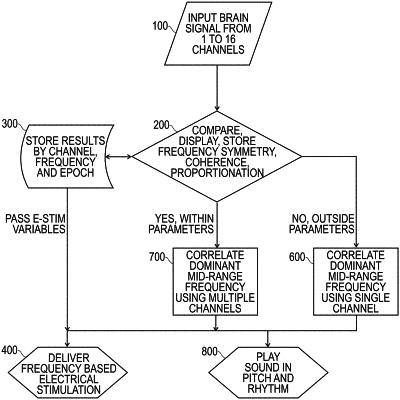| CPC A61N 1/36025 (2013.01) [A61N 1/36031 (2017.08); A61N 1/36034 (2017.08)] | 18 Claims |

|
1. A method for decreasing brain asymmetry comprising:
(a) simultaneously measuring electromagnetic activity of a user's brain through a set of channels, wherein the set of channels comprises
(i) a first pair of corresponding lobe channels, wherein the first pair of corresponding lobe channels is comprised of a right first lobe channel and a left first lobe channel, and
(ii) a second pair of corresponding lobe channels, wherein the second pair of corresponding lobe channels is comprised of a right second lobe channel and a left second lobe channel,
wherein each channel is configured to measure electromagnetic energy in a region of a brain of a user and to generate a measurement of electromagnetic energy and wherein the first pair of corresponding lobe channels is configured to measure electromagnetic energy from corresponding left-right regions of a first lobe and the second pair of corresponding lobe channels is configured to measure electromagnetic energy from corresponding left-right regions of a second lobe, wherein the first lobe is not the same as the second lobe;
(b) determining whether there is a threshold difference in energy between energies measured for any single frequency or for any one or more ranges of frequencies as measured between each channel of each pair of corresponding lobe channels,
(c) when there is a determination of a threshold difference in energy,
(i) activating a first correlation algorithm, wherein for each of a first plurality of frequencies from a set of dominant middle range brain wave frequencies from a lobe for which there has been a determination of a threshold difference in energy, the first correlation algorithm identifies an acoustic stimulus, and
(ii) activating a second correlation algorithm, wherein for each of a second plurality of frequencies from the set of dominant middle range brain wave frequencies from the lobe for which there has been a determination of a threshold difference in energy, intermittently the second correlation algorithm identifies an electric stimulus, wherein the second plurality of frequencies is a subset of the first plurality of frequencies,
(d) creating a variable sequence of acoustic stimuli by combining each acoustic stimulus identified in (c)(i) and playing said variable sequence of acoustic stimuli through a sound output device, and
(e) delivering to the user each electric stimulus identified in (c)(ii), wherein when each electric stimulus is delivered to the user, an acoustic stimulus that correlates with the same dominant middle range brain wave frequency is simultaneously delivered.
|